Unit 5 Into the unknown Developing ideas课件(共43张PPT) 2024-2025学年高二英语外研版(2019)选择性必修4
文档属性
| 名称 | Unit 5 Into the unknown Developing ideas课件(共43张PPT) 2024-2025学年高二英语外研版(2019)选择性必修4 |  | |
| 格式 | pptx | ||
| 文件大小 | 19.5MB | ||
| 资源类型 | 教案 | ||
| 版本资源 | 外研版(2019) | ||
| 科目 | 英语 | ||
| 更新时间 | 2025-04-22 20:55:05 | ||
图片预览

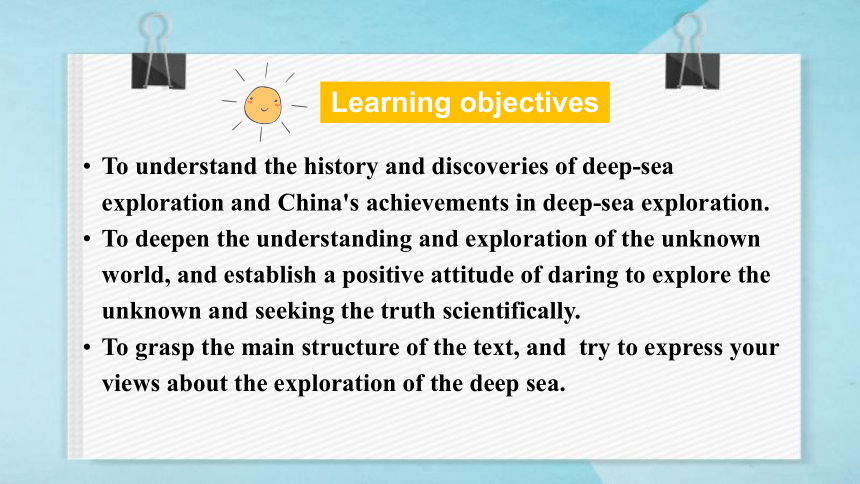

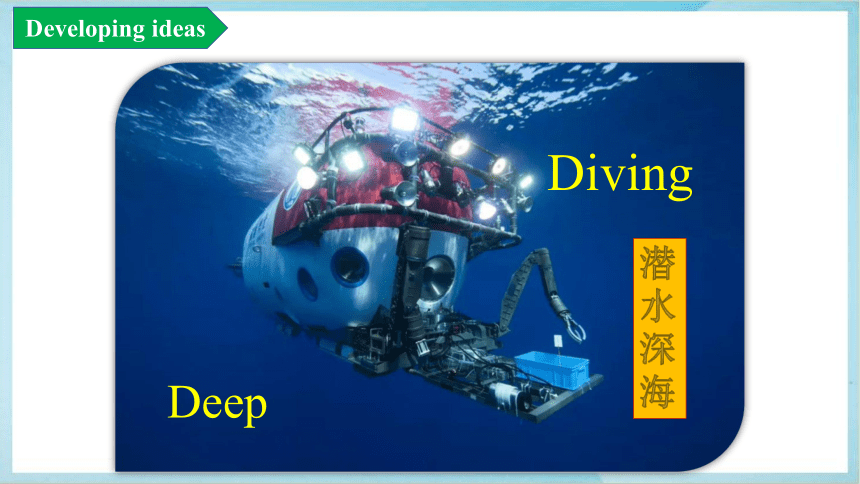


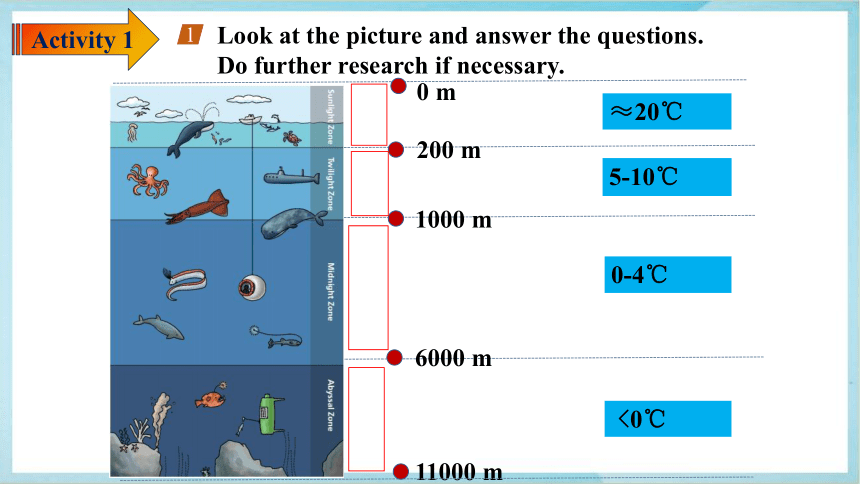
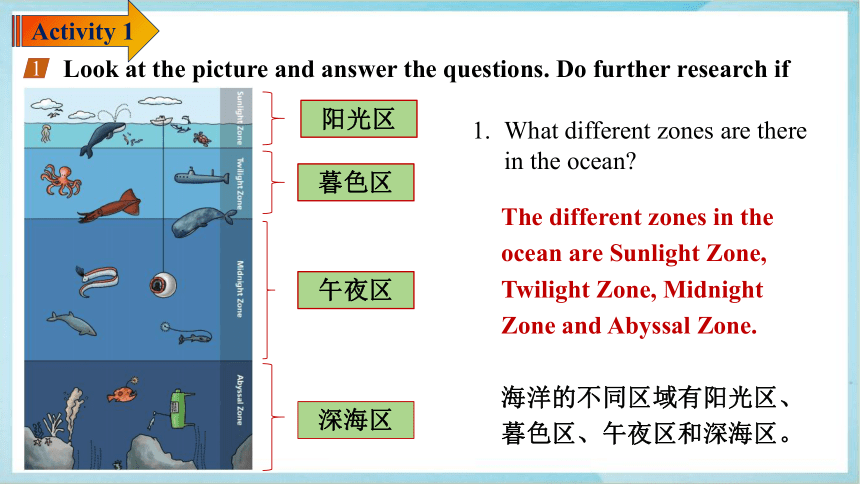

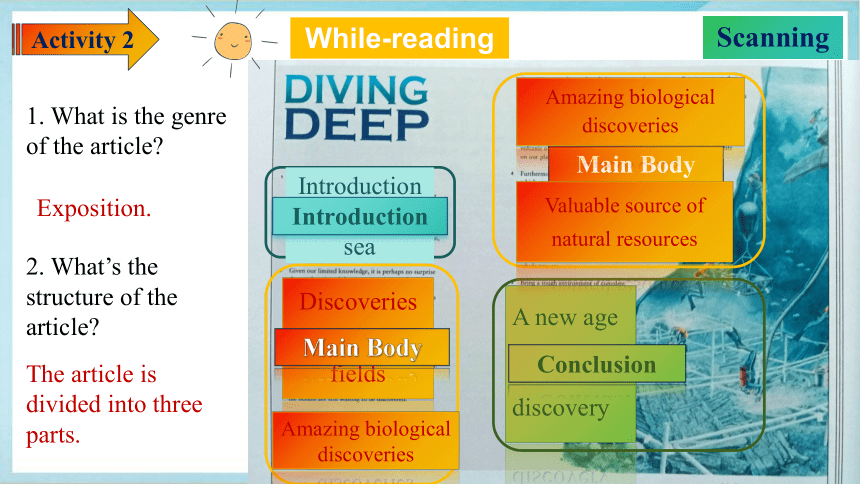

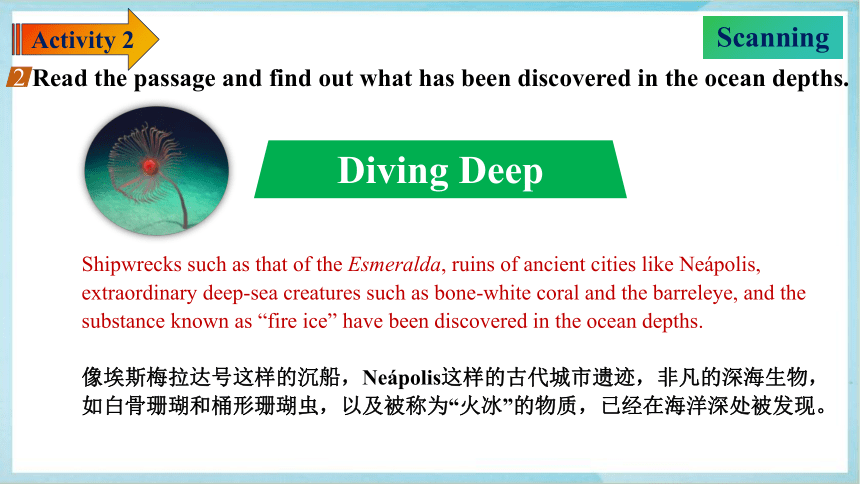
文档简介
(共43张PPT)
Unit 5 Developing ideas
DIVING DEEP
潜入深海
阅读课件
To understand the history and discoveries of deep-sea exploration and China's achievements in deep-sea exploration.
To deepen the understanding and exploration of the unknown world, and establish a positive attitude of daring to explore the unknown and seeking the truth scientifically.
To grasp the main structure of the text, and try to express your views about the exploration of the deep sea.
Learning objectives
* shipwreck n. 失事的船;沉船 74
* archaeological adj. 考古学的;考古的 74
* coral n. 珊瑚 75
millimetre n. 毫米 75
* barreleye n. 管眼鱼 75
* upwards adv. 向上,朝上 75
* trench n.海狗 75
* equivalent adj. 等同的;等值的;相当的
75
* stack v. (使)整齐地堆起;摞起 75
* furthermore adv. 此外;而且;不仅如此
76
* notable adj. 显要的;显著的;值得注意的 76
substance n. 物质 76
* vessel n. 船;舰 76
drilling n. 钻探;勘探 76
vol (=volume/ v lju m/) n. (书的)卷,册
80
Words and expressions
Diving
Deep
Developing ideas
潜水深海
Have you ever dived into the sea
Lead-in
What do you know about the sea world
200 m
1000 m
6000 m
11000 m
0 m
≈20℃
5-10℃
0-4℃
<0℃
Look at the picture and answer the questions. Do further research if necessary.
1
Activity 1
Look at the picture and answer the questions. Do further research if necessary.
What different zones are there in the ocean
The different zones in the ocean are Sunlight Zone, Twilight Zone, Midnight Zone and Abyssal Zone.
海洋的不同区域有阳光区、暮色区、午夜区和深海区。
1
阳光区
暮色区
午夜区
深海区
Activity 1
2.Which parts of the ocean do you think have been explored
3.What do you know about the deepest part of the ocean
Sunlight Zone, Twilight Zone and Midnight Zone.
阳光区,暮色区和午夜区。
The deeper the part of the ocean is, the fewer living things there are.
海洋越深,生物就越少。
Look at the picture and answer the questions. Do further research if necessary.
1
Activity 1
1. What is the genre of the article
2. What’s the structure of the article
Introduction to the deep sea
Discoveries in scientific fields
Amazing biological discoveries
A new age of oceanic discovery
Exposition.
The article is divided into three parts.
Introduction
Main Body
Main Body
Conclusion
Amazing biological discoveries
Valuable source of natural resources
Activity 2
While-reading
Scanning
Introduction to the deep sea
Discoveries in scientific fields
Amazing biological discoveries
A new age of oceanic discovery
DIVING DEEP
Introduction
Main Body
Conclusion
Valuable source of natural resources
Structure of the passage
Activity 2
Scanning
Read the passage and find out what has been discovered in the ocean depths.
Diving Deep
Shipwrecks such as that of the Esmeralda, ruins of ancient cities like Neápolis, extraordinary deep-sea creatures such as bone-white coral and the barreleye, and the substance known as “fire ice” have been discovered in the ocean depths.
像埃斯梅拉达号这样的沉船,Neápolis这样的古代城市遗迹,非凡的深海生物,如白骨珊瑚和桶形珊瑚虫,以及被称为“火冰”的物质,已经在海洋深处被发现。
2
Activity 2
Scanning
Ocean exploration
3,000,000 shipwrecks lying under waters across the globe represent attempts over the centuries to explore Earth’s furthest corners.
Esmeralda, the earliest wreck from the age of the European exploration of Asia.
Given our limited knowledge, the exploration of the oceans continues to lead to discoveries in various scientific fields.
Para.1
Activity 3
Archaeological exploration
As with the discovery of the Esmeralda, many archaeological finds are made in shallow waters near the coast including whole cities buried beneath the waves. One such find is the ancient Roman city of Neapolis, discovered off the coast of Tunisia.
Para.2
Activity 3
Believed to have been buried underwater by a tsunami in the fourth century AD, the ruins of Neapolis are almost 2000 years old. The remaining streets and buildings offer a window into a fascinating period in our history.
Para.2
Activity 3
However, we are only beginning to overcome the challenges of pressure, darkness and extreme cold at vast depths. Fragments of the past lying deep beneath the oceans are still waiting to be discovered.
Para.2
Activity 3
biological exploration
In these waters, more than 200 metres deep, where light cannot reach, are extraordinary creatures that appear as if they are straight out of science fiction.
The dark zones of the oceans may contain up to 90 per cent of the planet’s fish.
Para.3
Activity 3
Imagine bone-white coral 6000 metres below the ocean’s surface, growing at the rate of only one or two millimetres per year.
Some of these could be 4000 years old .
Para.3
Activity 3
Swimming through these black depths is the barreleye, strange fish with eyes that can look upwards through its transparent forehead.
Activity 3
Para.3
Para.3
Activity 3
In addition, China’s underwater vessels, such as the Jiaolong and Shenhai Youngshi, have been holds the record for the deepest dive by a manned submarine, at 7062 metres, giving China its place alongside the world’s top ocean explorers.
The research conducted by these vessels is giving scientists a greater understanding of how the sea bed was formed, as well as helping identify areas for deep-sea drilling, taking deep-sea exploration into a whole new era.
Para.4
Activity 3
Being a tough environment of complete darkness, enormous pressure and intense cold, the ocean depths have long been beyond the reach of human exploration. However, through closer international scientific, economic and cultural cooperation, we are all becoming part of a global mission to open up our planet’s final frontier.
A new age of oceanic discovery
Humankind is entering a new age of oceanic discovery, and the world beneath the waves may one day be almost as familiar to us as the land we walk upon today.
Para.5
Activity 3
5. We are entering a new age of oceanic discovery.
1. We have little knowledge of Earth’s sea bed.
2. Many archaeological
finds are made in shallow waters.
3. There are extraordinary creatures in the deep sea.
4. The oceans are a valuable source of natural resources.
Activity 4
Read for general ideas
Diving deep
Para. 1: Introduce the topic.
Para. 2-4:
Ocean
___________
Para. 2: the _______ of Neapolis
Para.3: amazing ______________ discoveries
Para. 5: ___________ is entering a new age of oceanic discovery.
Humankind
ruins
Para.4: __________ of natural resources
biological
discovery
exploration
Activity 4
Read for the structure
MODERN AGE: exploring ________________
________________ exploration
Finding ancient ruins in __________________.
Working to overcome challenges and make discoveries at _____________.
Example:
_______________________
deep sea
Archaeological
shallow waters
vast depths
the ruins of Neapolis
Activity 4
Read for ocean exploration
MODERN AGE: exploring ________________
deep sea
___________ exploration
Containing about 90 per cent of ________________.
Helping comprehend ____________________________________.
Example:
____________________
_________________
___________________________________________________
Biological
the capacity for life on our planet
the planet’s fish
bone-white coral
the barreleye
life to be found even around the deep-sea volcanic openings
Activity 4
Read for ocean exploration
Discovery of natural resources
Discovering new natural resources.
Studying ______________
Identifying areas for __________________
Example:
____________________
___________________________
the sea bed
deep-sea drilling
“fire ice”
China’s underwater vessels
MODERN AGE: exploring ________________
deep sea
Read for ocean exploration
Activity 4
1. What’s the main idea of the passage
A. There are millions of shipwrecks lying under waters.
B. Human’s exploration deep into the sea.
C. The tough environment of the sea bed.
D. Some new discoveries made by the scientists in the deep sea.
2. Which of the following is TRUE according to the passage
A. We have known more about the earth than the moon.
B. Even a whole city may be buried under the waters.
C. Most of the fishes live in shallow waters.
D. Humans have reached the deepest area of the ocean in a
submarine (潜艇).
B
B
Comprehensive understanding
Activity 4
Learn the writing techniques
Statistics
Activity 5
Examples in Paragraph 2:
whole city buried beneath the waves
Roman city of Neapolis
location:
____________________________
time: ______________
cause:______________________
off the coast of Tunisia
tsunami
the 4th century
Learn the writing techniques
Activity 5
Examples
surface
200 metres
dark zone
6000 metres deep
8000 metres
Name:______________
Age: ________________
Name: _______________________
Features: _____________________
_____________________
barreleye
transparent head
Eyes can look upwards
life to be found even around the deep sea vocalnic openings
bone-white coral
4000 years old
Examples in Paragraph 3:
Learn the writing techniques
Activity 5
The use of statistics and examples make the passage more convincing.
China’s achievements:
New natural resource:
___________
2. Underwater vessels:
________________________
fire ice
Jiaolong & Shenhai Yongshi
Examples in Paragraph 4:
Learn the writing techniques
Activity 5
Careful reading
Discourse markers
(语篇标记)
These markers function like road signs, helping you connect ideas and understand the writer’s attitude and opinions.
As you read, notice the discourse markers used in the text, eg in addition, also, however, furthermore, as well as.These markers function like road signs, helping you connect ideas and understand the writer's attitude and opinions.
当你阅读时,注意文本中使用的语篇标记,例如addition, also, however, furthermore, as well as。这些标记的作用就像路标,帮助你把想法联系起来,理解作者的态度和观点。
Activity 5
Think about the structure of the passage and complete the diagram.
3
deep sea
Archaeological
shallow waters
vast depths
the ruins of Neápolis
Biological
the planet’s fish
the capacity for life on our planet
bone-white coral
the barreleye
life to be found even around the
deep-sea volcanic openings
the sea bed
deep-sea drilling
“fire ice”
China’s underwater vessels
Activity 5
Why do you think the author uses statistics in the passage
2. What other example of ocean exploration do you know of Share one with the class.
Another example is the exploration of the Mariana Trench, the deepest part of the ocean, where the submersible *Trieste* reached the Challenger Deep in 1960, and later, James Cameron's *Deepsea Challenger* in 2012.
One notable example of ocean exploration is the discovery of the RMS Titanic wreck in 1985 by Robert Ballard and his team, using advanced deep-sea submersibles to locate the shipwreck nearly 4,000 meters below the surface.
Think & Share
Maybe the economy drives the exploration of the oceans.
Activity 6
Post-reading
3. What do you think drives the exploration of the oceans
4. What common message do the two reading passages in this unit convey How do they each build upon this idea
The use of statistics makes the passage more convincing.
Both passages convey the message that humans have the desire and means to explore the unknown.
The first passage does this by looking at our fascination with history’s greatest mysteries, while the second passage looks at pioneering exploration of Earth’s oceans.
Activity 6
Think & Share
Look at the diagram below and brainstorm examples of how ocean exploration affects your daily life.
Organise your talk by completing the diagram with your examples.
Give your talk to the class.
Now think about how well you contributed to the group work and what you could do to improve.
Work in groups. Give a talk about the influences of ocean exploration on your daily life.
4
Activity 7
1 About what time did the Esmeralda set sail
A In 1920. B In 1520. C In 1820. D In 1620.
2 What caused the ancient Roman city of Neapolis to be buried underwater according to the passage
A A terrible earthquake.
B A volcanic eruption.
C A tsunami.
D A hurricane.
3 According to the biological discoveries, which of the following is right
A Most of the planet’s fish live deep into the ocean.
B Creatures can’t live without light.
C Bone-white coral grows fast below the ocean’s surface.
D There is no life around the deep-sea volcanic openings.
B
C
A
Reading comprehension
Activity 8
4 Which of the achievements makes China the world’s top ocean explorers
A The discovery of “fire ice”.
B The discovery of the ruins of Neapolis.
C The discovery of the Esmeralda.
D China’s vessel, Jiaolong, holds the record for the deepest dive by a manned
submarine.
5 What’s the author’s attitude towards ocean exploration
A Unfavourable.
B Negative.
C Too challenging.
D Supportive.
D
D
Activity 8
Reading comprehension
Nowadays, we have been exploring oceans and made great achievements. As 1________ the discovery of the Esmeralda, many archaeological finds are made in shallow waters near the coast, one of 2________ is the ancient Roman city of Neapolis. 3_________(believe) to have been buried underwater by a tsunami in the fourth century AD, the ruins are almost 2000 years old. The 4__________(remain) streets and buildings offer a window into a fascinating period in our history.
Amazing biological discoveries are also being made. Extraordinary creatures are living more than 200 metres deep into the ocean, 5_______ light can’t reach. Even in the very deepest ocean trenches that are more than 8000 metres below the surface, there is still life 6____________(find).
with
which
Believed
remaining
where
to be found
Grammar filling
Activity 8
Besides, the oceans are a valuable source of natural resources, most notable of which is China’s discovery of 7__________ ice-like substance, known as “fire ice” . In addition, China’s underwater vessels have been exploring waters at 8___________(deep) of thousands of metres.
The Jiaolong even holds the record for the deepest dive by a manned submarine , at 7062 metres, 9__________(give) China its place alongside the world’s top ocean explorers.
Despite many challenges, through closer international cooperation, the world beneath the waves may one day be almost 10__________ familiar to us as the land we walk upon today.
an
depths
giving
as
Activity 8
Grammar filling
请就中国在深海探索方面取得的成就,用高中所学有关英语词汇谈谈呼吁人类通过国际合作,共同进行深海探秘的重要性。词数不要超过150词。
Homework
Sample
China has made remarkable achievements in deep-sea exploration, such as the Jiaolong submersible reaching depths of over 7,000 meters, showcasing its advanced technology and commitment to uncovering ocean mysteries. However, the vast and complex ocean requires global cooperation. International collaboration can pool resources, share knowledge, and reduce risks, ensuring sustainable exploration. By working together, humanity can better understand marine ecosystems, protect biodiversity, and address challenges like climate change. Let us unite to explore the deep sea, not for competition, but for the shared future of our planet.
Unit 5 Developing ideas
DIVING DEEP
潜入深海
阅读课件
To understand the history and discoveries of deep-sea exploration and China's achievements in deep-sea exploration.
To deepen the understanding and exploration of the unknown world, and establish a positive attitude of daring to explore the unknown and seeking the truth scientifically.
To grasp the main structure of the text, and try to express your views about the exploration of the deep sea.
Learning objectives
* shipwreck n. 失事的船;沉船 74
* archaeological adj. 考古学的;考古的 74
* coral n. 珊瑚 75
millimetre n. 毫米 75
* barreleye n. 管眼鱼 75
* upwards adv. 向上,朝上 75
* trench n.海狗 75
* equivalent adj. 等同的;等值的;相当的
75
* stack v. (使)整齐地堆起;摞起 75
* furthermore adv. 此外;而且;不仅如此
76
* notable adj. 显要的;显著的;值得注意的 76
substance n. 物质 76
* vessel n. 船;舰 76
drilling n. 钻探;勘探 76
vol (=volume/ v lju m/) n. (书的)卷,册
80
Words and expressions
Diving
Deep
Developing ideas
潜水深海
Have you ever dived into the sea
Lead-in
What do you know about the sea world
200 m
1000 m
6000 m
11000 m
0 m
≈20℃
5-10℃
0-4℃
<0℃
Look at the picture and answer the questions. Do further research if necessary.
1
Activity 1
Look at the picture and answer the questions. Do further research if necessary.
What different zones are there in the ocean
The different zones in the ocean are Sunlight Zone, Twilight Zone, Midnight Zone and Abyssal Zone.
海洋的不同区域有阳光区、暮色区、午夜区和深海区。
1
阳光区
暮色区
午夜区
深海区
Activity 1
2.Which parts of the ocean do you think have been explored
3.What do you know about the deepest part of the ocean
Sunlight Zone, Twilight Zone and Midnight Zone.
阳光区,暮色区和午夜区。
The deeper the part of the ocean is, the fewer living things there are.
海洋越深,生物就越少。
Look at the picture and answer the questions. Do further research if necessary.
1
Activity 1
1. What is the genre of the article
2. What’s the structure of the article
Introduction to the deep sea
Discoveries in scientific fields
Amazing biological discoveries
A new age of oceanic discovery
Exposition.
The article is divided into three parts.
Introduction
Main Body
Main Body
Conclusion
Amazing biological discoveries
Valuable source of natural resources
Activity 2
While-reading
Scanning
Introduction to the deep sea
Discoveries in scientific fields
Amazing biological discoveries
A new age of oceanic discovery
DIVING DEEP
Introduction
Main Body
Conclusion
Valuable source of natural resources
Structure of the passage
Activity 2
Scanning
Read the passage and find out what has been discovered in the ocean depths.
Diving Deep
Shipwrecks such as that of the Esmeralda, ruins of ancient cities like Neápolis, extraordinary deep-sea creatures such as bone-white coral and the barreleye, and the substance known as “fire ice” have been discovered in the ocean depths.
像埃斯梅拉达号这样的沉船,Neápolis这样的古代城市遗迹,非凡的深海生物,如白骨珊瑚和桶形珊瑚虫,以及被称为“火冰”的物质,已经在海洋深处被发现。
2
Activity 2
Scanning
Ocean exploration
3,000,000 shipwrecks lying under waters across the globe represent attempts over the centuries to explore Earth’s furthest corners.
Esmeralda, the earliest wreck from the age of the European exploration of Asia.
Given our limited knowledge, the exploration of the oceans continues to lead to discoveries in various scientific fields.
Para.1
Activity 3
Archaeological exploration
As with the discovery of the Esmeralda, many archaeological finds are made in shallow waters near the coast including whole cities buried beneath the waves. One such find is the ancient Roman city of Neapolis, discovered off the coast of Tunisia.
Para.2
Activity 3
Believed to have been buried underwater by a tsunami in the fourth century AD, the ruins of Neapolis are almost 2000 years old. The remaining streets and buildings offer a window into a fascinating period in our history.
Para.2
Activity 3
However, we are only beginning to overcome the challenges of pressure, darkness and extreme cold at vast depths. Fragments of the past lying deep beneath the oceans are still waiting to be discovered.
Para.2
Activity 3
biological exploration
In these waters, more than 200 metres deep, where light cannot reach, are extraordinary creatures that appear as if they are straight out of science fiction.
The dark zones of the oceans may contain up to 90 per cent of the planet’s fish.
Para.3
Activity 3
Imagine bone-white coral 6000 metres below the ocean’s surface, growing at the rate of only one or two millimetres per year.
Some of these could be 4000 years old .
Para.3
Activity 3
Swimming through these black depths is the barreleye, strange fish with eyes that can look upwards through its transparent forehead.
Activity 3
Para.3
Para.3
Activity 3
In addition, China’s underwater vessels, such as the Jiaolong and Shenhai Youngshi, have been holds the record for the deepest dive by a manned submarine, at 7062 metres, giving China its place alongside the world’s top ocean explorers.
The research conducted by these vessels is giving scientists a greater understanding of how the sea bed was formed, as well as helping identify areas for deep-sea drilling, taking deep-sea exploration into a whole new era.
Para.4
Activity 3
Being a tough environment of complete darkness, enormous pressure and intense cold, the ocean depths have long been beyond the reach of human exploration. However, through closer international scientific, economic and cultural cooperation, we are all becoming part of a global mission to open up our planet’s final frontier.
A new age of oceanic discovery
Humankind is entering a new age of oceanic discovery, and the world beneath the waves may one day be almost as familiar to us as the land we walk upon today.
Para.5
Activity 3
5. We are entering a new age of oceanic discovery.
1. We have little knowledge of Earth’s sea bed.
2. Many archaeological
finds are made in shallow waters.
3. There are extraordinary creatures in the deep sea.
4. The oceans are a valuable source of natural resources.
Activity 4
Read for general ideas
Diving deep
Para. 1: Introduce the topic.
Para. 2-4:
Ocean
___________
Para. 2: the _______ of Neapolis
Para.3: amazing ______________ discoveries
Para. 5: ___________ is entering a new age of oceanic discovery.
Humankind
ruins
Para.4: __________ of natural resources
biological
discovery
exploration
Activity 4
Read for the structure
MODERN AGE: exploring ________________
________________ exploration
Finding ancient ruins in __________________.
Working to overcome challenges and make discoveries at _____________.
Example:
_______________________
deep sea
Archaeological
shallow waters
vast depths
the ruins of Neapolis
Activity 4
Read for ocean exploration
MODERN AGE: exploring ________________
deep sea
___________ exploration
Containing about 90 per cent of ________________.
Helping comprehend ____________________________________.
Example:
____________________
_________________
___________________________________________________
Biological
the capacity for life on our planet
the planet’s fish
bone-white coral
the barreleye
life to be found even around the deep-sea volcanic openings
Activity 4
Read for ocean exploration
Discovery of natural resources
Discovering new natural resources.
Studying ______________
Identifying areas for __________________
Example:
____________________
___________________________
the sea bed
deep-sea drilling
“fire ice”
China’s underwater vessels
MODERN AGE: exploring ________________
deep sea
Read for ocean exploration
Activity 4
1. What’s the main idea of the passage
A. There are millions of shipwrecks lying under waters.
B. Human’s exploration deep into the sea.
C. The tough environment of the sea bed.
D. Some new discoveries made by the scientists in the deep sea.
2. Which of the following is TRUE according to the passage
A. We have known more about the earth than the moon.
B. Even a whole city may be buried under the waters.
C. Most of the fishes live in shallow waters.
D. Humans have reached the deepest area of the ocean in a
submarine (潜艇).
B
B
Comprehensive understanding
Activity 4
Learn the writing techniques
Statistics
Activity 5
Examples in Paragraph 2:
whole city buried beneath the waves
Roman city of Neapolis
location:
____________________________
time: ______________
cause:______________________
off the coast of Tunisia
tsunami
the 4th century
Learn the writing techniques
Activity 5
Examples
surface
200 metres
dark zone
6000 metres deep
8000 metres
Name:______________
Age: ________________
Name: _______________________
Features: _____________________
_____________________
barreleye
transparent head
Eyes can look upwards
life to be found even around the deep sea vocalnic openings
bone-white coral
4000 years old
Examples in Paragraph 3:
Learn the writing techniques
Activity 5
The use of statistics and examples make the passage more convincing.
China’s achievements:
New natural resource:
___________
2. Underwater vessels:
________________________
fire ice
Jiaolong & Shenhai Yongshi
Examples in Paragraph 4:
Learn the writing techniques
Activity 5
Careful reading
Discourse markers
(语篇标记)
These markers function like road signs, helping you connect ideas and understand the writer’s attitude and opinions.
As you read, notice the discourse markers used in the text, eg in addition, also, however, furthermore, as well as.These markers function like road signs, helping you connect ideas and understand the writer's attitude and opinions.
当你阅读时,注意文本中使用的语篇标记,例如addition, also, however, furthermore, as well as。这些标记的作用就像路标,帮助你把想法联系起来,理解作者的态度和观点。
Activity 5
Think about the structure of the passage and complete the diagram.
3
deep sea
Archaeological
shallow waters
vast depths
the ruins of Neápolis
Biological
the planet’s fish
the capacity for life on our planet
bone-white coral
the barreleye
life to be found even around the
deep-sea volcanic openings
the sea bed
deep-sea drilling
“fire ice”
China’s underwater vessels
Activity 5
Why do you think the author uses statistics in the passage
2. What other example of ocean exploration do you know of Share one with the class.
Another example is the exploration of the Mariana Trench, the deepest part of the ocean, where the submersible *Trieste* reached the Challenger Deep in 1960, and later, James Cameron's *Deepsea Challenger* in 2012.
One notable example of ocean exploration is the discovery of the RMS Titanic wreck in 1985 by Robert Ballard and his team, using advanced deep-sea submersibles to locate the shipwreck nearly 4,000 meters below the surface.
Think & Share
Maybe the economy drives the exploration of the oceans.
Activity 6
Post-reading
3. What do you think drives the exploration of the oceans
4. What common message do the two reading passages in this unit convey How do they each build upon this idea
The use of statistics makes the passage more convincing.
Both passages convey the message that humans have the desire and means to explore the unknown.
The first passage does this by looking at our fascination with history’s greatest mysteries, while the second passage looks at pioneering exploration of Earth’s oceans.
Activity 6
Think & Share
Look at the diagram below and brainstorm examples of how ocean exploration affects your daily life.
Organise your talk by completing the diagram with your examples.
Give your talk to the class.
Now think about how well you contributed to the group work and what you could do to improve.
Work in groups. Give a talk about the influences of ocean exploration on your daily life.
4
Activity 7
1 About what time did the Esmeralda set sail
A In 1920. B In 1520. C In 1820. D In 1620.
2 What caused the ancient Roman city of Neapolis to be buried underwater according to the passage
A A terrible earthquake.
B A volcanic eruption.
C A tsunami.
D A hurricane.
3 According to the biological discoveries, which of the following is right
A Most of the planet’s fish live deep into the ocean.
B Creatures can’t live without light.
C Bone-white coral grows fast below the ocean’s surface.
D There is no life around the deep-sea volcanic openings.
B
C
A
Reading comprehension
Activity 8
4 Which of the achievements makes China the world’s top ocean explorers
A The discovery of “fire ice”.
B The discovery of the ruins of Neapolis.
C The discovery of the Esmeralda.
D China’s vessel, Jiaolong, holds the record for the deepest dive by a manned
submarine.
5 What’s the author’s attitude towards ocean exploration
A Unfavourable.
B Negative.
C Too challenging.
D Supportive.
D
D
Activity 8
Reading comprehension
Nowadays, we have been exploring oceans and made great achievements. As 1________ the discovery of the Esmeralda, many archaeological finds are made in shallow waters near the coast, one of 2________ is the ancient Roman city of Neapolis. 3_________(believe) to have been buried underwater by a tsunami in the fourth century AD, the ruins are almost 2000 years old. The 4__________(remain) streets and buildings offer a window into a fascinating period in our history.
Amazing biological discoveries are also being made. Extraordinary creatures are living more than 200 metres deep into the ocean, 5_______ light can’t reach. Even in the very deepest ocean trenches that are more than 8000 metres below the surface, there is still life 6____________(find).
with
which
Believed
remaining
where
to be found
Grammar filling
Activity 8
Besides, the oceans are a valuable source of natural resources, most notable of which is China’s discovery of 7__________ ice-like substance, known as “fire ice” . In addition, China’s underwater vessels have been exploring waters at 8___________(deep) of thousands of metres.
The Jiaolong even holds the record for the deepest dive by a manned submarine , at 7062 metres, 9__________(give) China its place alongside the world’s top ocean explorers.
Despite many challenges, through closer international cooperation, the world beneath the waves may one day be almost 10__________ familiar to us as the land we walk upon today.
an
depths
giving
as
Activity 8
Grammar filling
请就中国在深海探索方面取得的成就,用高中所学有关英语词汇谈谈呼吁人类通过国际合作,共同进行深海探秘的重要性。词数不要超过150词。
Homework
Sample
China has made remarkable achievements in deep-sea exploration, such as the Jiaolong submersible reaching depths of over 7,000 meters, showcasing its advanced technology and commitment to uncovering ocean mysteries. However, the vast and complex ocean requires global cooperation. International collaboration can pool resources, share knowledge, and reduce risks, ensuring sustainable exploration. By working together, humanity can better understand marine ecosystems, protect biodiversity, and address challenges like climate change. Let us unite to explore the deep sea, not for competition, but for the shared future of our planet.
